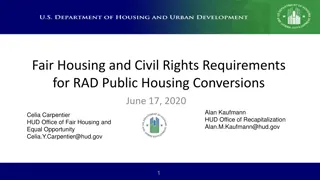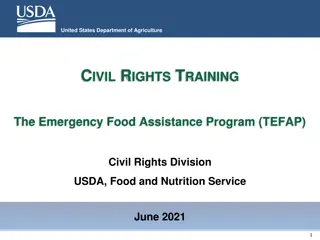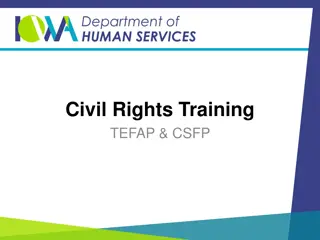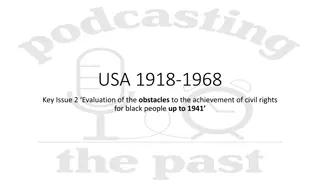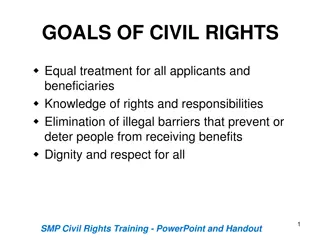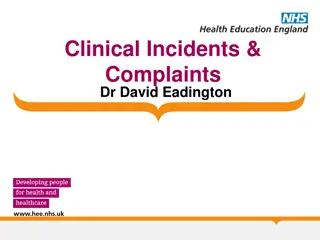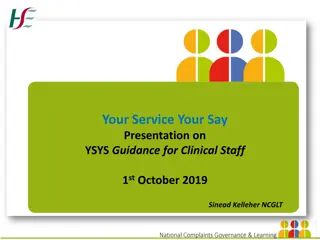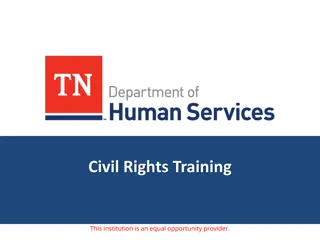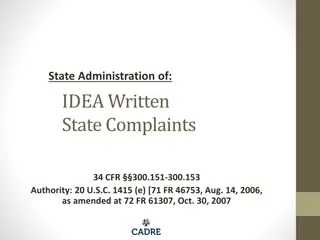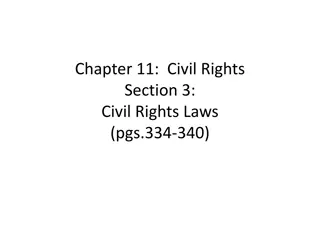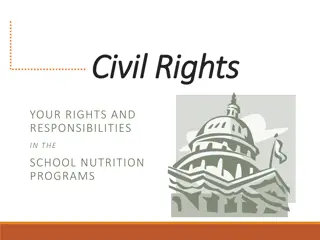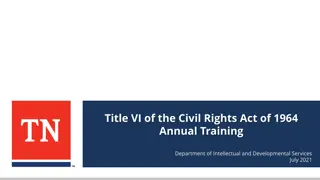Title VI Complaints and Regulations Overview in Civil Rights Programs
Explore Title VI complaints process and regulations under the Civil Rights Act of 1964, ensuring nondiscrimination in federally funded programs. Learn about complaint laws, investigation procedures, and the roles of entities such as the Federal Highway Administration, US Department of Justice, and US Department of Transportation. Understand the protections against discriminatory acts based on race, color, or national origin, and the steps involved in addressing Title VI complaints effectively.
Download Presentation

Please find below an Image/Link to download the presentation.
The content on the website is provided AS IS for your information and personal use only. It may not be sold, licensed, or shared on other websites without obtaining consent from the author.If you encounter any issues during the download, it is possible that the publisher has removed the file from their server.
You are allowed to download the files provided on this website for personal or commercial use, subject to the condition that they are used lawfully. All files are the property of their respective owners.
The content on the website is provided AS IS for your information and personal use only. It may not be sold, licensed, or shared on other websites without obtaining consent from the author.
E N D
Presentation Transcript
Title VI Complaints Ken Woodruff Civil Rights Program Manager FHWA Indiana Division
Complaint Laws & Regulations Title VI of the Civil Rights Act of 1964 42 USC 2000d US Department of Justice 28 CFR Part 42 US Department of Transportation 49 CFR Part 21.11 Federal Highway Administration 23 CFR Part 200.9(b)(3)
Title VI of the Civil Rights Act No person in the United States shall, on the basis of race, color, or national origin, be excluded from participation in, be denied the benefits of, or be subjected to discrimination under any program or activity receiving Federal financial assistance Note that the Civil Rights Restoration Act clarified that nondiscrimination protections extend to any program of the recipient, not only those funded with federal dollars
US Department of Justice 28 CFR Part 42 DOJ resources Title VI Legal Manual Investigation Procedures Manual for the Investigation and Resolution of Complaints Alleging Violations of Title VI and Other Nondiscrimination Statutes https://www.justice.gov/crt/fcs/T6manual
US Department of Transportation 49 CFR Part 21.11 21.11(b) = Complaints: 21.11(c) = Investigations 21.11(d) = Resolution of Matters 21.11(e) = Retaliatory Acts Prohibited
Federal Highway Administration 23 CFR Part 200.9(b)(3) Develop procedures for prompt processing and disposition of Title VI complaints received directly Investigated by trained personnel
Federal Highway Administration 10 Steps to Support Complaint Process 23 CFR Part 200.9(b)(3) Procedures Identify complaint by race, color, gender or national origin Who is the recipient (your LPA or a subrecipients?) The nature of the complaint The date the complaint was filed and investigation completed
Federal Highway Administration 10 Steps to Support Complaint Process 23 CFR Part 200.9(b)(3) - Procedures Complaint disposition All other pertinent information Keep a log of all complaints filed Keep a copy of the complaint Keep a copy of the Investigation Report **Forward the complaint to the funding agency
Procedures for Filing a T6 Complaint Who Can Complain? - Any person (*or group of people) who believes they have been discriminated based on race, color, or national origin in any program/service provided by a recipient of federal dollars. Where Can Someone File? A person* can file with a recipient, a subrecipient, the FHWA (in cases of highway programs) the USDOT (in cases of transportation programs) or the Department of Justice.
Procedures for Filing a T6 Compliant What Should a Look Like? Complaints MUST be in writing and signed. Filed by mail, fax, in-person, email or PHONE HOWEVER >> if by phone the agency must transcribe the discussion, then meet with or send the transcripts to the complainant for edits and signature. The complaint drives the investigation, so an accurate understanding of the issue(s) is important.
Procedures for Filing a T6 Compliant Complaints should contain: A written explanation of what has happened The date that the discrimination last occurred and if on-going A way to contact the complainant The basis of the complaint (race, color, national origin) Identification of the person/people alleged to have discriminated The facts and circumstances that lead to the allegation
Procedures for Filing a T6 Compliant How are Complaints Routed? FHWA Division Offices do not investigate Title VI Complaints State DOTs/Recipients/Subrecipients should not investigate themselves. Example: Person files a complaint against a State DOT, that SDOT would forward the complaint to the FHWA Division Office, then that would be forwarded to FHWA Office of Civil Rights (FHWA-HCR) in Washington DC
Procedures for Filing a T6 Compliant How are Complaints Routed? If a SDOT receives a complaint about a subrecipient, then the State may investigate the subrecipient or the State can refer the matter to FHWA-HCR If the FHWA Division Office receives a complaint about the SDOT, then it is referred to HCR for investigation
Processing T6 Complaints Send complainant an acknowledgement letter (include timeline in your T6 complaint procedures). Let the complainant(s) know your agency has received their complaint The agency in receipt of the complaint must determine if the complaint is accepted , referred or dismissed These decision are based solely on the facts in the case. Investigators must look for the truth, and not advocate during the fact-finding.
Potential Outcomes for a T6 Complaint Accept: Complaint meets all the required timelines or timelines are waived, contains sufficient information is provided to make a prima facie case of discrimination, and is a matter pertaining to the agency s jurisdiction Preliminary Review: It is unclear whether a prima facie case can be established. The matter can be either dismissed as not sufficient to establish discrimination occurred, or the agency can seek additional facts. Note that it is the complainants responsibility to provide evidence of discrimination though an agency may (should) seek corroborating information.
Potential Outcomes for a T6 Complaint Procedural Dismissal: If a complaint is not filed timely and no extension is granted, not signed or there are other procedural shortcomings. Referral/Dismissal: If the Agency given the complaint lacks jurisdiction over the matter, but complaint is otherwise submitted in a timely manner it will either be: Referred to the agency that is authorized to handle the matter -OR- Dismissed and the complainant will be provided information as to how to contact the agency that does have jurisdiction
What are the Timeframes For State DOTs 23 CFR Part 2009(b)(3) requires investigations be completed within 60 days from the receipt of a complaint. Spell timeframes out in your complaint procedures. Acknowledgement Letter Initial Investigation Complaint Report Corrective Action Plan Establish realistic and aggressive timelines for remedies
How do Agencies Gather Information Recipients are required to keep detailed records on how they are complying with Title VI Annual Title VI Plan Make monitoring data available to investigating agencies. Follow USDOJ s guidance in their Complaint Investigation Procedures Manual Seek relevant documents (primary, secondary, tertiary), conduct interviews, conduct site visits...
Potential Outcomes of Investigation Finding of No Violation Fails to Comply with Title VI Resolved Informally by Agreement Mutually agreed by Complainant and Respondent Letter of Finding (LOF) Issued Noncompliance Corrective Action Plan within 90-days Outlines the Issue(s) and the proposed solution(s) Submitted for Approval to Investigating Agency
Letter of Finding If the Investigating Agency Approves the Action Plan: The respondent will be provided a reasonable time to implement the plan. At the end of the timeline, the investigating agency will assess if the respondent has sufficiently addressed the violation
Misc. Thoughts Remain Neutral Where You Stand is Where You Sit BUT you are not an advocate, rather you are a arbiter FACTS-FACTS-FACTS Be Quick If there is discrimination, move as quickly to resolve the problem as you can. Someone may be suffering harm
Misc. Thoughts Be Earnest and Honest Set realistic timelines Work hard to meet them Let the complainant know where the matter stands.
IT MATTERS If there is discrimination in your programs that are causing harm to any person it matters that we work to overcome the discrimination.
Thank You Questions?



